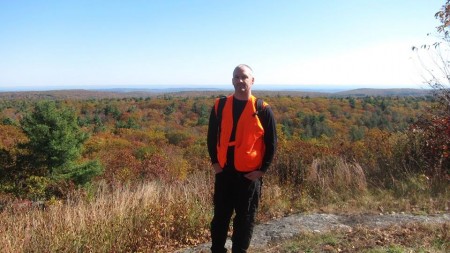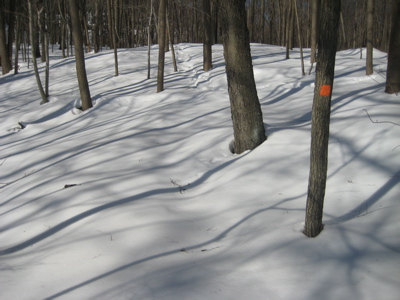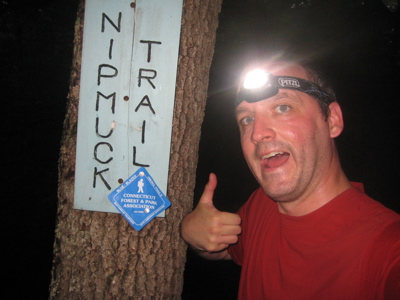*Hike Smart, Hike Safe*
Don’t be Stupid
Hike Safely
I’m writing this page for a very simple reason: Because I get asked fairly often by novice hikers to point them to trails that would suit them. I take great pleasure introducing people to some of what Connecticut has to offer – often so close to high population densities.
But conversely, I get very sad when I hear about a poor experience due to mistakes made during preparation. So here it is: My VERY basic list of things you MUST do before you hike. Yes, even in Connecticut, even “close” to your house.
Assess your abilities. Don’t get going on one of the harder/longer hikes around to be a a tough guy or gal if you just had – or should have – heart surgery. Be smart, please.

Wear blaze orange so you don’t get shot
Notes about your clothes:
Underwear: Women, I assume you know what to do regarding your bras and panties. I don’t.. but I assume thongs, as much as I Iove ‘em on the right woman, are probably a bad idea. Guys, just wear some. If your thighs rub, take precautions like spandex shorts or higher crotched pants or whatever. Chafing down there is an awful problem to have.
Base layers: If you’re going to hike more than a few miles over other than flat terrain on a non-65 degree sunny day, I’d suggest you think about a few things. “Cotton Kills” is a saying used in the hiking community. Cotton shirts/jeans are awful when wet. They are the worst and they don’t dry and they will kill you via hypothermia which you may not know you have until you no longer know your name. Sweat wet can do this to you, under the right (very wrong) conditions, believe it or not. If you’re going to do this hiking thing for a while, just go buy some store-brand REI poly-blend hiking shirts and pants. You’ll be amazed at their wicking and drying capabilities.
Shoes/socks: Whatever works for you. I prefer trail shoes to boots and running shoes, no matter the weather or conditions. But that’s just me. I also have these super thin liner socks I wear under high-quality hiking socks, even on 100 degree days. It seems to alleviate any blistering. Just take it slow and listen to your feet. If you feel rubbing (a “hot spot”) STOP! And address it immediately. Trust me. I did that here and can’t imagine how much worse this would have been if I didn’t do that.
Coats/hats/gloves/layers/rain gear: Check the weather. Wear/bring layers. Know when the sun will set. If you’re planning on lunching on a western ridge, know that it’ll be windy and 10 degrees colder than it was on the hike up the eastern side. Pay attention to stuff like that.
And pay attention to poison ivy. I’m hopelessly alergic to it and wound up in the hospital once with it “in my blood” so to speak. Here’s a handy quiz to help you out. I can spot the stuff from a mile away now.
…………………………………………………….
Another important note:
I’ve probably hiked more miles than anyone you know. And yet, I still do every single of the following things, every single time I go out into the woods.
These 4 things weigh nothing and take maybe 2 minutes total . I do these the night before every hike, without fail.
1. I look at the map of where I’m going to gauge what I’ll be doing.
2. I tell someone (my wife in my case) exactly where I’m parking and where I’m hiking and give as accurate a return-time as I can.
3. I determine where I’ll be parking; if it’s a crappy dirt road, I drive the car better suited for that.
4. I look at the weather for where I’m going so I don’t dress stupidly.

3 feet of virgin snow at Sleeping Giant. You, too, can do it if properly prepared
Here is what I bring with me every single time:
Note: Apart from the water, the other things take up very little space and weigh next to nothing.
1. As detailed a map of the hike as I can find.
2. Two times the water I think I’ll need. (I’ve given water to others quite often.)
3. I always wear long pants now after too many years of poison ivy/ticks.
4. Compass (you should know which bearing gets you to the nearest road)
5. Whistle (3 short blasts 1 minute apart is the US recognized distress signal)
6. Advil, because why not?
7. Water filter in the summer.
8. Blaze orange vest during hunting season on non-Sundays
9. 2 bandanas
10. maybe 25% more food than you’d think; salty, sweet and protein. Must haves.
11. Ziploc Bags (to keep wallet/electronics dry if it rains)
12. Waterproof matches
13. Swiss Army knife
14. Head lamp

The sun has set on me before I wanted it to… but you see? I was prepared.
Here are some other things to seriously consider:
1. Your precious smart-phone.
2. Proper layers/clothes/hat/etc.
3. Sunscreen, bug spray, Neosporin, bandages
4. dry towel(s), shirt, etc to clean up afterwards at your car. Trust me, if you’re all sweaty or drenched from rain, having a towel and a change of clothes when you’re done is heavenly.
5. Duct Tape. I use it on my ankles as blister protection with new shoes/boots.
6. Gold Bond (or similar) powder. Chaffed inner things ruin a day. This fixes it.
6. Camera
7. Hiking poles, Katoolah STABILicers– I love both when needed
8. knee/ankle braces – I carry them because I’m old
9. A positive attitude. C’mon, this stuff is fun!
Got it? Good. Now, back to CTMQ’s Hiking Pages.






A great addition to the site. Informative and fun, as it should be. :)
Comment #1 on 11.18.13 at 5:48 pm